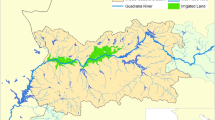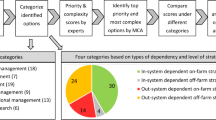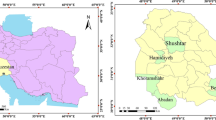Abstract
There is an increasing call for agricultural water management to adapt to climate change, yet efforts in this direction often consider only the policy dimension, or planned adaptation perspective. However, it is crucial to include an assessment of farmers’ autonomous adaptation into the design and evaluation of rural policy measures. Amongst others, this helps avoid doubling efforts and ensure the effectiveness of the policies proposed. Moreover, farmers are the primary receivers of climate-proofing agricultural policies. Hence, to maximise a policy’s success, it is fundamental to include farmers in its design phases. Farmers autonomously react to changes and policies should build on ongoing efforts. This work, carried out in the Veneto Region of Italy, proved the advantages of approaching adaptation as a continuum between autonomous and planned, rather than addressing the two separately. We first collected farmers’ perceptions of and adaptations to change through an online questionnaire. We then identified the major determinants of their choice to adapt through a multinomial probit model. We analysed farmers’ expectations of effectiveness of five different adaptation options for water conservation, via an ad-hoc online decision support system tool, mDSSweb. Our work provided policy makers with information on how different typologies of farmers are (not) adapting their practices to climate change. We clearly identified which groups of farmers the policies should target first and with what type of support. Both policy makers and farmers reacted positively to our approach and expressed interest in up-scaling it to become more inclusive.


Similar content being viewed by others
Explore related subjects
Discover the latest articles and news from researchers in related subjects, suggested using machine learning.References
Ajao A, Ogunniyi L (2011) Farmers strategies for adapting to climate change in Ogbomoso agricultural zone of Oyo State. Agris On-line Pap Econ Inform 3:3–13
Anwar M, Liu D, Macadam I, Kelly G (2012) Adapting agriculture to climate change: a review. Theor Appl Climatol 2012:1–21. doi:10.1007/s00704-012-0780-1
Below T, Artner A, Siebert R, Siebert S (2010) Micro-level practices to adapt to climate change for African small-scale farmers: a review of selected literature. IFPRI Discussion Paper 00953. http://www.ifpri.org/sites/default/files/publications/ifpridp00953.pdf
Bockel I (2009) How to mainstream climate change adaptation and mitigation into agriculture policies. In: Climate change impacts on agriculture and food security and disaster risk management as entry point for climate change adaptation, no. 77 in EasyPol—Resources for policy makers, FAO
Bojovic D, Bonzanigo L, Giupponi C (2012) Drivers of change in Southern European agriculture: online participatory approaches for the analysis of planned and autonomous adaptation strategies. In: International congress on environmental modelling and software, managing resources of a limited planet, sixth biennial meeting, iEMSs, Leipzig (D), 1–5 July 2012
Boko M, Niang I, Nyong A, Vogel C, Githeko A, Medany M, Osman-Elasha B, Tabo R, Yanda P (2007) Africa climate change 2007: impacts, adaptation and vulnerability. In: Parry ML, Canziani OF, Palutikof JP, van der Linden PJ, Hanson CE (eds) Contribution of working group II to the fourth assessment report of the intergovernmental panel on climate change. Cambridge University Press, Cambridge, pp 433–467
Borsotto P, Henke R, Macri M, Slavioni C (2008) Participation in rural landscape conservation schemes in Italy. Landsc Res 33(3):347–363. doi:10.1080/01426390802046044
Bradshaw B, Dolan H, Smit B (2004) Farm-level adaptation to climatic variability and change: crop diversification in the Canadian prairies. Clim Change 67(1):119–141. doi:10.1007/s10584-004-0710-z
Bryan E, Deressa TT, Gbetibouo GA, Ringler C (2009) Adaptation to climate change in Ethiopia and South Africa: options and constraints. Environ Sci Policy 12(4):413–426. doi:10.1016/j.envsci.2008.11.002
Bryan E, Ringler C, Okoba B, Roncoli C, Silvestri S, Herrero M (2013) Adapting agriculture to climate change in Kenya: household strategies and determinants. J Environ Manag 114:26–35. doi:10.1016/j.jenvman.2012.10.036
Cameron A, Trivedi T (2005) Microeconometrics: methods and applications. Cambridge University Press, New York
Coldiretti V (2013) Proposte per lo sviluppo rurale 2014–2020 del veneto, approvato dalla giunta esecutiva della federazione regionale coldiretti del veneto il 22 luglio 2013. Tech. rep, Coldiretti
Defrancesco E, Gatto P (2008) Factors affecting farmers’ participation in agri-environmental measures: a Northern Italian perspective. J Agric Econ 59(1):114–131. doi:10.1111/j.1477-9552.2007.00134.x
Deressa TT, Hassan RM, Ringler C, Alemu T, Yesuf M (2009) Determinants of farmers’ choice of adaptation methods to climate change in the Nile Basin of Ethiopia. Glob Environ Change 19(2):248–255. doi:10.1016/j.gloenvcha.2009.01.002
Deressa TT, Hassan RM, Ringler C (2011) Perception of and adaptation to climate change by farmers in the Nile Basin of Ethiopia. J Agric Sci 149(01):23–31. doi:10.1017/S0021859610000687
Deressa T, Hassan R, Alemu T, Yesuf M, Ringler C (2008) Analyzing the determinants of farmers: a choice of adaptation methods and perceptions of climate change in the Nile Basin of Ethiopia. IFPRI Discussion Paper 000798
European Commission (2005) Council regulation no 1698/2005 of 20 september 2005 on support for rural development by the European Agricultural Fund for Rural Development (EAFRD). Tech. rep., EC
European Commission (2013a) An EU strategy on adaptation to climate change, communication from the commission to the European Parliament, the Council, the European Economic and Social Committee and the Committee of the Regions COM (213) 216 Final. Tech. rep, EC, Brussels
European Commission (2013b) Guidelines on developing adaptation strategies—commission staff working document, accompanying the document: an EU strategy on adaptation to climate change 134 final. Tech. rep, EC, Brussels
Fischer G, Shah M, N Tubiello F, van Velhuizen H (2005) Socio-economic and climate change impacts on agriculture: an integrated assessment, 1990–2080. Philos Trans R Soc Lond B Biol Sci 360(1463):2067–2083. doi:10.1098/rstb.2005.1744
Fosu-Mensah BY, Vlek PLG, MacCarthy DS (2012) Farmers perception and adaptation to climate change: a case study of Sekyedumase district in Ghana. Environ Dev Sustain 14(4):495–505. doi:10.1007/s10668-012-9339-7
Gbetibouo GA (2009) Understanding farmers’ perceptions and adaptations to climate change and variability: the case of the Limpopo Basin, South Africa. IFPRI Discussion Paper 00849
Gbetibouo GA, Hassan RM, Ringler C (2010) Modelling farmers’ adaptation strategies for climate change and variability: the case of the Limpopo Basin, South Africa. Agrekon 49(2):217–234. doi:10.1080/03031853.2010.491294
Giupponi C, Fassio A, Lasut A, Mysiak J, Sgobbi A (2006) Network analysis, creative system modelling and decision support: the NetSyMoD approach. Nota di Lavoro, Fondazione Eni Enrico Mattei, No 462006
Golob TF, Regan AC (2002) Trucking industry adoption of information technology: a multivariate discrete choice model. Transp Res Part C Emerg Technol 10(3):205–228. doi:10.1016/S0968-090X(02)00006-2
Hassan R, Nhemachena C (2008) Determinants of African farmers’ strategies for adapting to climate change: multinomial choice analysis. Spec Issue Clim Change Afr Agric 2(1):83–104
Hausman J, Wise D (1978) A conditional probit model for qualitative choice: discrete decisions recognizing interdependence and heterogeneous preferences. Econometrica 46:403–426. doi:10.2307/1913909
IPCC (2007) Climate change 2007: impacts, adaptation and vulnerability. In: Parry ML, Canziani OF, Palutikof JP, van der Linden PJ, Hanson CE (eds.) Contribution of working group II to the fourth assessment report of the intergovernmental panel on climate change. Cambridge University Press, Cambridge
ISTAT (2012) Censimento generale dell agricoltura: results 2012
Jones A (2007) Applied econometrics for health economists: a practical guide, second edn. In: Prepared for the Office of Health Economics, Radcliffe Publishing
Kabubo-Mariara J (2008) Climate change adaptation and livestock activity choices in Kenya: an economic analysis. Nat Res Forum 32(2):131–141. doi:10.1111/j.1477-8947.2008.00178.x
Kamari J, Alcamo J, Barlund I, Kabat P, Kok K (2008) Envisioning the future of water in Europe—the SCENES project. IN: E-Water: official publication of the European Water Association (EWA), pp 1–28. http://edepot.wur.nl/17434
Kebede D, Adane H (2011) Climate change adaptations and induced farming livelihoods. Drylands Coordination Group, Norway Report no.64
Leclere D, Jayet PA, de Noblet-Ducoudra N (2013) Farm-level autonomous adaptation of European agricultural supply to climate change. Ecol Econ 87:1–14. doi:10.1016/j.ecolecon.2012.11.010
Maddison D (2007) The perception of and adaptation to climate change in Africa. In: Policy Research Working Paper 4308, Development Research Group, Sustainable Rural and Urban Development Team, The World Bank
Malik A, Qin X, Smith S (2010) Autonomous adaptation to climate change: a literature review. In: IIEP Working Paper 2010–24
Nhemachena C, Hassan R (2007) Micro-level analysis of farmers adaptation to climate change in Southern Africa. In: IFPRI Discussion Paper 000714, International Food Policy Research Institute
Piya L, Maharjan KL, Joshi NP (2013) Determinants of adaptation practices to climate change by Chepang households in the rural Mid-Hills of Nepal. Reg Environ Change 13(2):437–447. doi:10.1007/s10113-012-0359-5
Reidsma P, Ewert F, Lansink AO, Leemans R (2010) Adaptation to climate change and climate variability in European agriculture: the importance of farm level responses. Eur J Agron 1:91–102. doi:10.1016/j.eja.2009.06.003
Seo SN, Mendelsohn R, Dinar A, Kurukulasuriya P (2009) Adapting to climate change mosaically: an analysis of african livestock management by agro-ecological zones. BE J Econ Anal Policy 9(2):1–37. doi:10.2202/1935-1682.1955
Veneto R (2011) Rapporto statistico 2011—il veneto si racconta, il veneto si confronta. Tech. rep., Regione Veneto—direzione sistema statistico regionale
Veneto R, Istituto Nazionale di Economia Agraria (2012) Programmazione sviluppo rurale 2014–2020 progetto di studio, analisi e supporto tecnico-scientifico. dgrn 2929 del 28 dicembre 2012. Tech. rep., INEA
Verbeek M (2014) A guide to modern econometrics. Appl Econ 8(4):125–132
van Vuuren DP, Lucas PL, Hilderink H (2007) Downscaling drivers of global environmental change: enabling use of global SRES scenarios at the national and grid levels. Glob Environ Change 17(1):114–130. doi:10.1016/j.gloenvcha.2006.04.004
Wu J, Babcock BA (1998) The choice of tillage, rotation, and soil testing practices: economic and environmental implications. Am J Agric Econ 80(3):494–511. doi:10.2307/1244552
Zucaro R, Povellato A (2009) Rapporto sullo stato dell’ irrigazione in veneto. In: Programma interregionale di monitoraggio dei sistemi irrigui delle regioni centro settentrionali. Tech. rep., Istituto Nazionale di Economia Agraria (INEA)
Acknowledgments
The authors wish to acknowledge the support from the Veneto Region and its Environmental Agency (ARPAV). This research has been funded by the ICARUS project, with the financial support of the Italian Institute for Environmental Protection and Research (ISPRA).
Author information
Authors and Affiliations
Corresponding author
Additional information
Editor: Xiangzheng Deng.
Appendix: The MNP model
Appendix: The MNP model
Suppose that a farmer i chooses alternative k and therefore, the difference between the latent variable and the \(J-1\) is defined as follows:
Where \(j'=j\) if \(j < k\) and \(j'=j-1\) if \(j >k\) such that \(j'=1,\ldots ,J-1\). The variance and covariance of the error terms \(u_{ij}\) are defined as \(Var(u_{ij})=Var(\epsilon _{ij}-\epsilon _{ik})=2\) and \(Cov(u_{ij},u_{im})=1\) for \(j'\ne m'\). The probability that alternative \(k\) is chosen is given by the following equation:
Rights and permissions
About this article
Cite this article
Bonzanigo, L., Bojovic, D., Maziotis, A. et al. Agricultural policy informed by farmers’ adaptation experience to climate change in Veneto, Italy. Reg Environ Change 16, 245–258 (2016). https://doi.org/10.1007/s10113-014-0750-5
Received:
Accepted:
Published:
Issue Date:
DOI: https://doi.org/10.1007/s10113-014-0750-5




